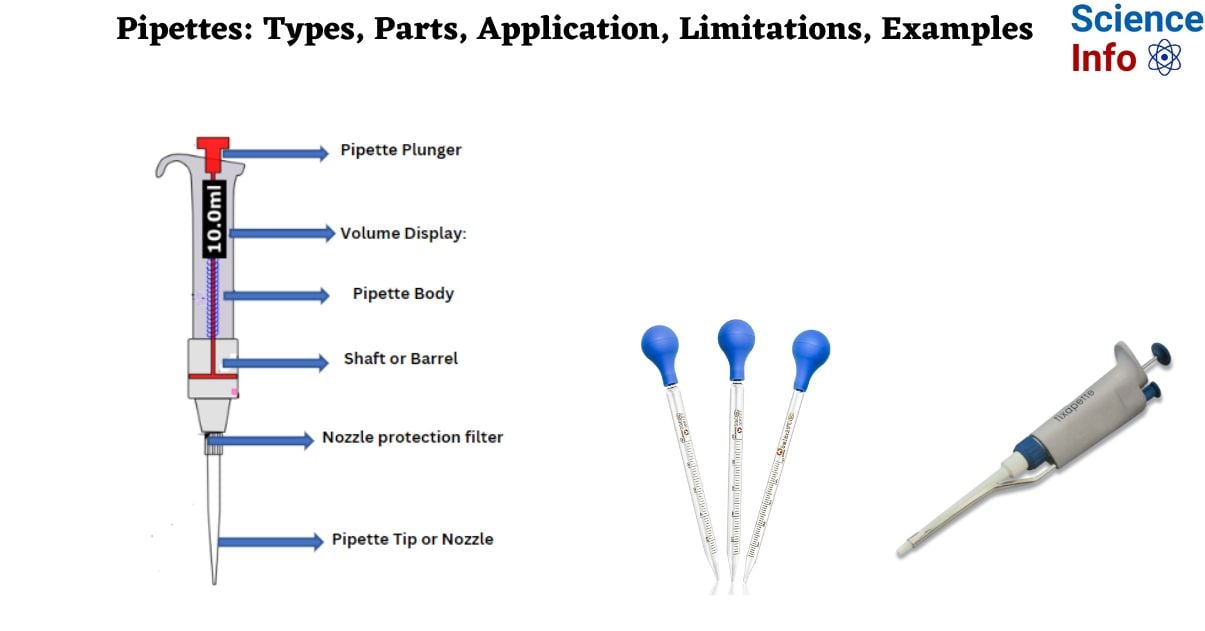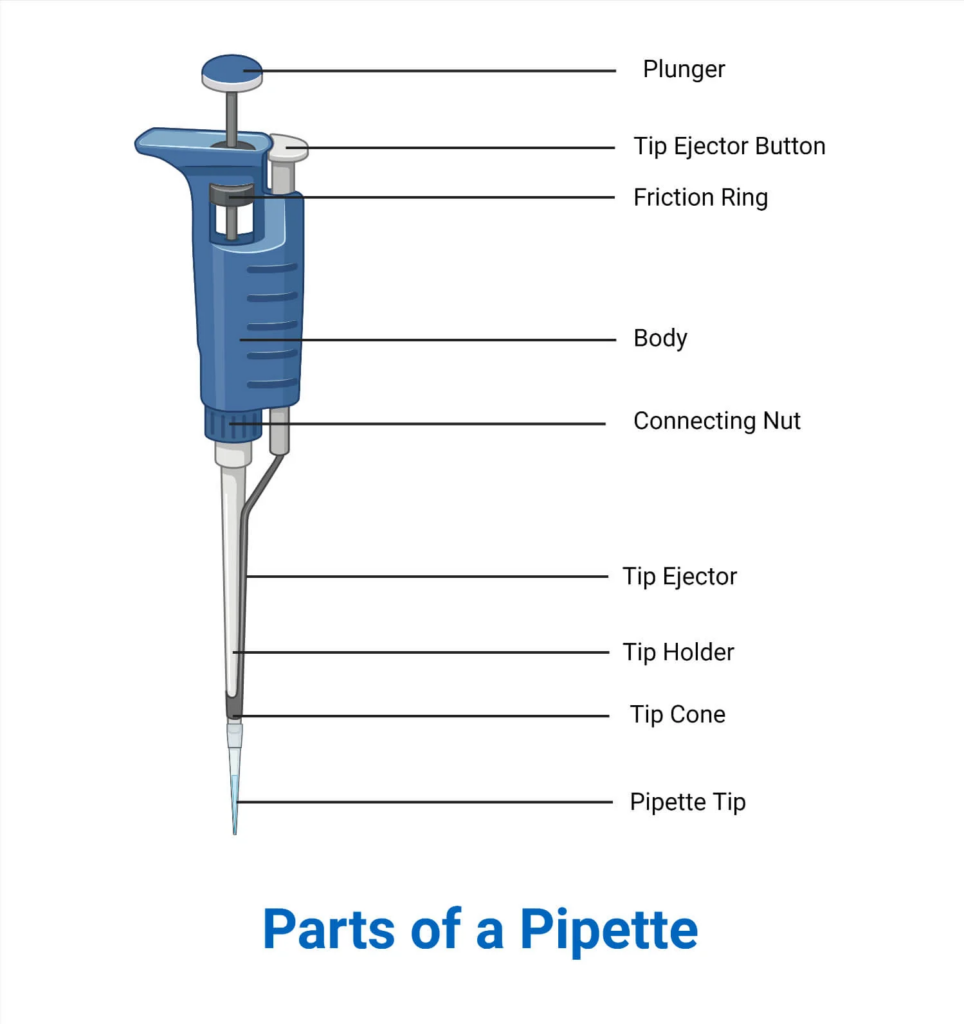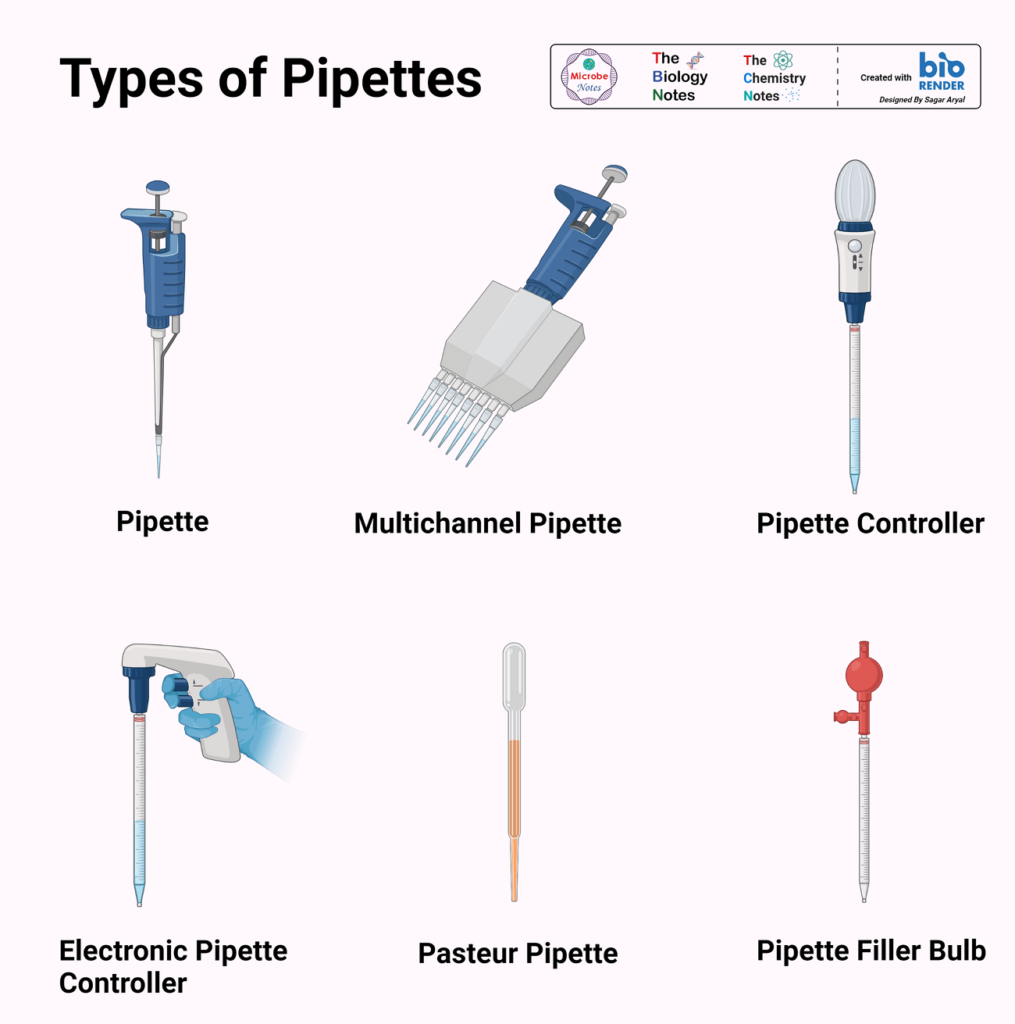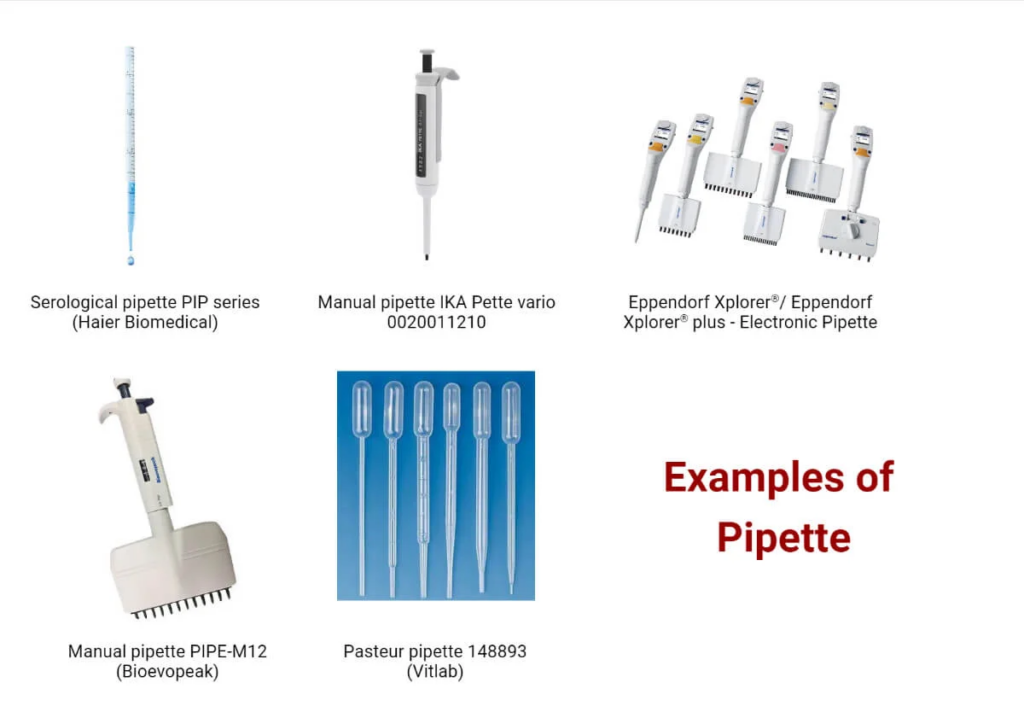Pipettes play a crucial role in dispensing small liquid volumes consistently and repeatedly. Various types of pipettes serve distinct purposes. Unmarked pipettes dispense liquids drop by drop without volume indicators. In contrast, some pipettes are designed for accurate measurement and delivery of precise volumes. Micropipettes, for instance, ensure microliter precision in liquid dispensation.

While most pipettes are crafted from glass, certain models utilize plastic. It’s important to note that these glassware items are not suitable for exposure to flames or extreme temperatures. Heat can deform pipettes, compromising their measurement accuracy. Therefore, it is essential to avoid subjecting pipettes to extreme temperature conditions.
Interesting Science Videos
Pipettes- Definition
A pipette is a laboratory tool for precisely measuring and transferring small quantities of liquid. It is a cylindrical glass or plastic tube with a narrow end for liquid transfer and a bulb or other mechanism for drawing the liquid up.
A pipette is a vital laboratory instrument utilized in fields like chemistry, biology, and medicine to accurately transfer measured liquid volumes between containers. It serves as a crucial tool for precise experimentation and research, particularly in dispensing various media.
The term “pipette” is derived from the French word “pipette,” signifying a “small pipe,” aligning with the device’s shape and purpose. Pipettes are available in diverse designs and materials, including glass, plastic, and electronic versions. Glass pipettes are commonly made from borosilicate glass, while plastic ones are constructed from polyethylene terephthalate (PET). Electronic pipettes incorporate microprocessors to enhance functionality and precision in liquid handling.
Pipettes are available for a number of uses and conditions, with each intended for specified volume ranges and, in some cases, specialized for specific liquid kinds. Despite technological developments in pipetting, the operation remains user-friendly, allowing those with little or no prior expertise to quickly learn the fundamentals of pipette use.
Structure and Parts of Pipette
A pipette, a fundamental laboratory instrument for precise liquid measurement and transfer, exhibits diverse types, yet its basic structure encompasses several integral components.
Pipette Body: Typically cylindrical, the main body of the pipette houses internal mechanisms and can be constructed from materials such as plastic or metal.
Pipette Tip or Nozzle: Situated at the lower part of the body, the tapered or conical pipette tip, often made from disposable plastic, directly interfaces with the aspirated liquid.
Pipette Plunger or Button: Positioned atop the body, the plunger or button, designed as a thumbwheel, push-button, or a similar mechanism, is pressed to aspirate and dispense liquid.
Volume Adjustment Mechanism: Featured on the pipette body, the volume adjustment mechanism allows users to set the desired aspiration volume.
Volume Display: Many pipettes incorporate a volume display, exhibiting the selected volume setting through a digital display, rotating scale, or a simple numerical indicator.
Ejector Button: Utilized for safe disposal, the ejector button causes the descent of a metal bar, expelling the disposable tip into a waste container.
Volume Lock: Some pipettes are equipped with a volume lock to prevent inadvertent volume changes during pipetting.
Shaft or Barrel: Connecting the body to the pipette tip, the shaft or barrel may have a smooth surface or textured grip for ease of handling.

In addition to these general components, specific parts of the pipette include:

Plunger: Used for both aspirating and dispensing the desired liquid volume.
Ejector Button: Initiates the descent of the metal bar, leading to the ejection of the pipette tip.
Shaft: In an air displacement pipette, the tube-like structure filled with air assists in liquid aspiration when the piston is pressed. Releasing the piston aids in liquid dispensing while refilling the shaft with air.
Tip Cone: The region where the pipette tip is affixed.
Pipette Tip: Constructed from polypropylene or molded plastic, this essential piece comes into direct contact with the liquid.
Working Principle of Pipette
The operational mechanism of a pipette is primarily founded on two fundamental mechanisms: the air displacement method and the positive displacement method. Both types of pipettes incorporate a piston within a capillary or cylinder. In air displacement pipettes, a specified volume of air is intentionally maintained between the piston and the liquid. Conversely, positive displacement pipetting entails the piston making direct contact with the fluid.
Air Displacement Method
This technique involves the telescopic movement of a spring, facilitating the piston’s suction and discharge of liquids. When the piston is pushed, a portion of air is expelled, creating a partial vacuum that draws in the liquid due to atmospheric pressure. Subsequently, the air is expelled to release the liquid. The pipette’s operation is adeptly managed by the spring’s expansion and contraction characteristics, allowing precise control over the pace and force of pipetting.
Positive Displacement Method
Positive displacement pipettes, commonly utilized for repetitive or specialized pipetting tasks, employ a disposable piston moving inside the tip. In this method, the upward movement of the piston draws the sample into the tip directly, eliminating the presence of an air cushion. As the piston descends, the chosen volume is accurately discharged.
In addition to these mechanisms, the overall working principles of a pipette encompass a fusion of mechanical and air displacement processes. The manual pipette operation involves:
Aspiration (Liquid Intake): Users choose the desired volume, depress the plunger, creating a partial vacuum that draws liquid into the pipette tip.
Dispensing: After aspirating, the pipette is repositioned, and the plunger is gradually released to dispense the liquid drop by drop.
Ejection of Tip: The disposable tip is expelled to prevent cross-contamination between diverse liquids or samples.
The accuracy and precision of a pipette hinge on the quality of its design and construction. Regular calibration and maintenance are imperative for ensuring accuracy, with various pipette types tailored to specific applications. Electronic or digital pipettes, for instance, come equipped with features such as programmable modes and multiple volume settings.
Furthermore, the core essence of the pipette lies in the piston pipette principle, leveraging air discharge for operation. The pipette’s capacity is determined by the movement distance in the piston sleeve. Different pipetting modes, encompassing built-in and external piston modes, offer adaptability in diverse applications.
Types of Pipettes
Pipettes come in various types, each tailored to specific laboratory tasks. Here’s an in-depth exploration of different pipette types based on their designs, applications, and functionalities.

Blowout Pipette
Features two small continuous bands on the upper end, ensuring precise dispensing of the last drop of liquid.
Application: Ideal for applications where complete liquid transfer is crucial.
Self-Draining Pipette
Lacks two small bands on the upper end, relying on gravity for liquid drainage.
Application: Suitable for situations where retaining the last drop is not critical.
Transfer (Disposable) Pipettes
Simple pipettes with a bulb for suction and dispensing of liquids, typically used for single applications.
Application: Commonly employed in straightforward liquid transfers, with disposal after a single use.
Ostwald-Folin Pipette
Transfer pipettes with a bulb at the lower end, designed for transferring viscous liquids like serum and blood.
Application: Widely used in clinical laboratories for specific liquid transfers.
Volumetric Pipettes
Equipped with a central bulb and calibrated markings for precise measurement of liquid volumes.
Application: Mainly used in quality-control labs for accurate and reproducible liquid transfers.
Mohr’s Pipette
A measuring pipette without a bulb, featuring calibrations along its body for less precise applications.
Application: Suitable for experiments where extremely high accuracy is not critical.
Serological Pipette
Measuring pipette with calibrations down to the tip, featuring a larger dispensing orifice for efficient liquid transfer.
Application: Commonly used for transferring small volumes, especially in medical testing.
Pasteur Pipette
Reusable pipettes with calibrations, utilized for transferring small liquid amounts.
Application: Ideal for precise liquid addition in various laboratory procedures.
Micropipette
Sophisticated instruments for accurate transfer of microliter or nanoliter volumes, featuring disposable tips.
Application: Essential in molecular biology labs, ensuring precision in minute liquid measurements.
Gilson Pipette
High-precision pipettes available in single and multichannel formats.
Application: Ideal for tasks requiring meticulous measurements in both single and multiple sample applications.
Eppendorf Pipette
Similar to micropipettes, commonly employed in molecular biology and biochemistry labs.
Application: Used for accurate and precise liquid measurements in various molecular applications.
Positive Displacement Pipette
Specially designed for highly viscous or volatile liquids, with a piston directly contacting the liquid.
Application: Perfect for tasks involving challenging liquid properties that may affect other pipette types.
Vacuum-assisted Pipettes
Available as volumetric or graduated, utilizing vacuum for liquid transfer.
Application: Useful in scenarios where vacuum assistance enhances the precision of liquid measurements.
Repeater Pipette
Facilitates repeated dispensing into multiple containers without pausing.
Application: Enhances speed and efficiency when dispensing the same quantities into various receptacles.
Single Channel vs. Multichannel Pipettes
Single-channel pipettes for individual tips, multichannel for simultaneous multiple transfers.
Application: Tailored to the specific needs of single or multiple sample applications.
Manual vs. Electronic Pipette
Manual relies on mechanical effort, electronic improves ergonomics and reduces force requirements.
Application: Choosing between manual and electronic depends on user preferences, precision needs, and ergonomic considerations.
Fixed vs. Adjustable Volume Pipette
Fixed-volume pipettes maintain a set volume, adjustable allows volume changes.
Application: Fixed for quick operations, adjustable for flexibility in volume changes.
Specific Purpose Pipette
Tailored for specific tasks, such as environmental hormone analysis or high-volume ultra macro-pipetting.
- Glass Tip Micropipettes for Environmental Hormone Analysis: Specifically designed for the analysis of environmental hormones. Glass tip ensures accurate and precise dispensing of small hormone sample volumes. Application: Handling sensitive hormone samples for reliable results in hormone analysis studies.
- High-Volume Ultra Macro-Pipettes: Engineered for handling large liquid volumes, with a dispensing capacity of up to 50 milliliters. Ideal for precise transfer and dispensing of substantial liquid amounts in various laboratory settings. Applications: Sample preparation, media dispensing, and bulk liquid transfers.
- Van Slyke Pipettes and Ostwald-Folin Pipettes: Van Slyke Pipettes are used in blood gas analysis to measure partial pressures of oxygen and carbon dioxide in blood samples. Ostwald-Folin Pipettes are applied in chemical analysis, particularly for determining viscosities and fluid properties.
- Glass Micropipettes: Fine glass capillary tubes for precise microinjections, cell manipulation, and delicate procedures. Pulled and shaped to have a very fine tip, enabling precise and controlled delivery of small liquid volumes. Applications: Biological and biomedical research tasks requiring meticulous liquid handling.
- Microfluidic Pipettes: Tailored for microfluidic systems involving precise manipulation of small fluid volumes in microchannels or devices. Engineered to handle microscale volumes and compatible with microfluidic platforms. Applications: Bioanalysis, drug discovery, and lab-on-a-chip technologies.
- Extremely Low-Volume Pipettes: Designed for handling ultra-low volumes of liquids, typically in microliter or nanoliter ranges. Applications: Molecular biology, genomics, proteomics, and other fields where precise and accurate dispensing of small volumes is crucial.
Pipette Operating Procedure
Preparation:
- Ensure the availability of a suitable disposable tip for the pipette.
- Retrieve a tip from the designated box and securely attach it to the pipette, ensuring proper fixation.
Volume Adjustment:
- Utilize the volume adjustment spinning dial on the pipette to set the desired transfer volume.
- Rotate the dial to increase or decrease the volume according to the specific requirements.
Aspiration:
- Hold the pipette in a vertical grip, ensuring a secure grasp.
- Gently press the plunger down until it reaches the first stop position, allowing the expulsion of air from the pipette.
Liquid Sampling:
- Submerge the pipette tip into the liquid component requiring sampling.
- While keeping the tip submerged, slowly release the plunger to draw up the liquid. For viscous liquids, briefly pause at the end to ensure complete aspiration.
Dispensing:
- Position the pipette tip inside the designated tube or container for liquid collection.
- Depress the plunger fully until it reaches the second stop position, facilitating the transfer of the entire liquid volume.
Tip Ejection:
- Upon completing the transfer, press the ejector button on the pipette to release and discard the used tip.
- Dispose of the used tip in the designated garbage can or container allocated for disposable pipette tips.
Application of Pipette
Applications of Pipettes in Chemical Analysis
Pipettes are indispensable in various chemical analyses, providing precision and control in laboratory procedures.
Titrations and Spectroscopic Analysis: Pipettes find common usage in titrations and sample preparation for spectroscopic analysis, allowing for accurate measurement and controlled transfer of liquids in analytical processes.
Preparing Solutions: Volumetric pipettes play a crucial role in preparing solutions of specific volumes and concentrations, ensuring precise concentration levels required for chemical experiments.
Sample Handling: Facilitating the transfer of small liquid volumes, pipettes are essential in handling samples and reagents in laboratory procedures.
Dilution: Used for reducing solution concentration by adding more solvent, pipettes enable controlled dilution, a fundamental step in various chemical processes.
Addition of Reagents: Pipettes allow precise and controlled addition of reagents to chemical reactions, ensuring accurate outcomes in reactions requiring specific reagent amounts.
Quality Control: In manufacturing processes, pipettes are employed for quality control purposes, ensuring products meet specified standards through accurate liquid handling.
pH Measurements: Applied in pH measurements where adjusting sample pH is necessary, pipettes enable controlled addition of acidic or basic solutions for pH adjustments.
Cell Culture: In cell culture techniques, pipettes are used for adding or removing small volumes of culture medium, ensuring even distribution of essential nutrients for cell growth.
Applications of Pipettes in Scientific Settings
Pipettes serve diverse applications in scientific and laboratory environments, contributing to precision and efficiency.
Cell Seeding and Culture: Achieving even distribution of cells during seeding, pipettes promote uniform cell growth, ensuring sterility and preventing clumping in T-flask cell cultures.
Microplate Applications: Extensively used in 96-well microplates for ELISA, PCR, and cell culture, pipettes with multiple channels enable efficient and precise liquid transfers.
Aliquoting and Multi-Dispensing: Electronic pipettes are employed for aliquoting reagents into multiple doses, facilitating accurate and consistent distribution of small liquid volumes, reducing handling time and errors.
Serological Applications: Serological pipettes are used in traditional laboratory settings for various applications, including gentle mixing of cell suspensions, volumetric measurements, and creating gradients in reagent layering.
Application of Pipettes in Laboratories
Pipettes serve as indispensable tools in laboratories, performing crucial tasks across various scientific disciplines.
Measuring Liquid Volumes: Widely used for accurate measurement of liquid volumes, from microliters to milliliters, pipettes are essential for preparing solutions, conducting titrations, and quantitative analyses.
Transferring Liquids: Facilitating safe and efficient transfer of liquids, pipettes minimize spills, particularly useful with small volumes or hazardous substances.
Dispensing Reagents: Essential for accurate dispensing of reagents into reactions, pipettes play a critical role in enzymatic assays, PCR reactions, and other sensitive procedures.
Sample Preparation: Commonly used in sample preparation for various analytical techniques, pipettes ensure precise transfer of sample aliquots for accurate and reproducible results.
DNA and RNA Work: Indispensable in molecular biology and genetic research, pipettes are used for measuring and transferring DNA and RNA in amplification, sequencing, and other molecular manipulations.
Drug Delivery: Employed in pharmaceutical research and clinical settings for precise drug delivery, pipettes prepare and administer controlled amounts of medications, ensuring accurate dosing and patient safety.
Microscopy: Crucial for preparing samples for microscopic examination, pipettes enable precise delivery of small volumes of cells, suspensions, or reagents onto microscope slides for detailed observation and analysis.
Advantages of Pipettes
Pipettes offer numerous benefits in laboratory environments, providing solutions to various challenges encountered during experiments. the advantages of pipettes extend beyond their precise measurements, encompassing user-friendly design, enhanced safety, increased productivity through automation, suitability for high throughput experiments, and versatility in handling diverse liquid types. Some key advantages of pipettes include:
User-friendly and Ergonomic Design: Pipettes are crafted with user comfort in mind, featuring ergonomic designs that allow for easy and precise handling. Their lightweight construction and adjustable volume settings enhance user-friendliness, reducing operator fatigue and ensuring a comfortable pipetting experience.
Enhanced Safety Measures:: When compared to traditional measuring cylinders, pipettes stand out as a safer alternative, especially when dealing with hazardous chemicals. The precise measurement and controlled dispensing capabilities of pipettes minimize the risk of spills and exposure to potentially harmful substances, enhancing overall laboratory safety.
Accurate and Precise Measurements: Volumetric pipettes, renowned for their exceptional accuracy, provide precise measurements critical for experiments. The narrow neck of these pipettes enables more accurate readings of the meniscus, ensuring the exact delivery of solutions and minimizing measurement errors for reliable results.
Increased Productivity with Automation: The advent of electronic pipettes introduces automation and advanced features that significantly boost laboratory productivity. By eliminating repetitive manual pipetting steps, electronic pipettes save time and reduce the likelihood of human errors, ultimately improving the reliability and reproducibility of experimental outcomes.
High Throughput Experiments with Multichannel Pipettes: Multichannel pipettes prove advantageous in high throughput experiments by allowing simultaneous pipetting into multiple wells or tubes. This feature enhances accuracy, efficiency, and reproducibility, making multichannel pipettes ideal for applications such as screening assays, plate-based assays, and sample preparations involving multiple samples.
Versatility in Liquid Handling: Pipettes exhibit remarkable versatility in handling various types of liquids, including foamy liquids, high vapor pressure liquids, and those with high viscosity. This flexibility makes pipettes adaptable to different liquid properties, ensuring consistent and reliable performance across a broad spectrum of laboratory applications.
Limitations of Pipettes
Economic Implications and Precision Specificity: Volumetric pipettes, acknowledged for their precision, come at a higher financial investment compared to alternative pipette types. Each volumetric pipette is engineered for a precise volume measurement and lacks adjustability, requiring the procurement of distinct pipettes for specific volume needs.
Flexibility Limitations: Despite their accuracy, volumetric pipettes are hindered by fixed volumes, posing constraints on adaptability. Addressing varying volume requirements mandates the utilization of separate pipettes, proving restrictive, particularly in experiments involving diverse sample volumes or necessitating adjustments during the procedure.
Human-Induced Errors with Graduated Pipettes: Distinguished by graduation marks along their length, graduated pipettes rely on the user’s precision in reading the meniscus and delivering the intended volume. Human errors, like inaccuracies in reading or volume adjustment, can introduce variability and reduce precision. Graduated pipettes are more susceptible to user-induced errors compared to volumetric counterparts.
Requirements for Calibration and Maintenance: Ensuring sustained accuracy and precision demands periodic calibration and maintenance of pipettes. Over time, deviations from calibrated settings can lead to inaccurate measurements. Stringent maintenance practices, including routine calibration and servicing, are imperative to minimize measurement errors and uphold result reliability.
Influence of Liquid Properties: The accurate and precise functioning of pipettes may be influenced by the specific properties of the handled liquid. Challenges arise with foamy or viscous solutions, where foaming can lead to inconsistent volume measurements and high-viscosity liquids may necessitate additional force for accurate aspiration and dispensing.
Contamination Risks and Cross-Contamination Mitigation: Of particular concern with reusable pipettes, ensuring proper cleaning and sterilization is crucial to prevent contamination and cross-contamination between samples. Inadequate cleaning practices may result in the carryover of residual materials, potentially compromising the accuracy and reliability of subsequent measurements or experiments.
Calibrating Pipette
Pipettes are vital tools in laboratories, ensuring precision in liquid transfers and accurate measurements. However, atmospheric pressure, humidity, and temperature changes over time can impact their calibration, leading to inaccuracies. Regular pipette calibration becomes crucial to maintaining measurement accuracy and securing reliable experimental data.
Calibrating a pipette involves comparing the dispensed volume with the selected volume to identify any discrepancies. Addressing these differences corrects calibration errors, ensuring ongoing accuracy. According to the Clinical and Laboratory Standards Institute (CLSI), pipettes should undergo calibration every 3-6 months for consistent and reliable performance.
Ensuring High Measurement Performance: Calibrating pipettes enhances their measurement performance, instilling confidence in their accuracy and minimizing the risk of errors. Consistent calibration promotes reliability, a crucial aspect for obtaining trustworthy and precise measurements.
Reliability and Accuracy: Regular and accurate pipette calibration ensures the reliability of measurements. Reliability is as significant as accuracy; unreliable measurements can lead to safety concerns, increased downtime, and financial constraints. Accuracy, a critical factor, is upheld through frequent maintenance and calibration to ensure precise pipette measurements.
Influential Factors in Pipette Calibration
Atmospheric Pressure: Changes in air pressure directly affect the volume of liquid dispensed by the pipette. Regular calibration compensates for these variations, preserving measurement accuracy.
Humidity: Elevated humidity levels may cause moisture to condense inside the pipette, potentially altering its calibration. Consistent calibration addresses these effects, ensuring precision in liquid transfers.
Temperature: Temperature fluctuations can cause liquid volume expansion or contraction, impacting pipette accuracy. Routine calibration compensates for these variations, maintaining the precision of measurements.
Examples of Pipettes in Different Applications
Serological Pipette PIP Series (Haier Biomedical)
- Specifically designed for cell and tissue cultivation and other biological research.
- Constructed from high-clarity polystyrene and individually wrapped in paper-plastic bags.
- Different colors distinguish pipettes of various diameters.
- Free from cytotoxicity, hemolysis, and pyrogens.
Manual Pipette IKA Pette Vario 0020011210 (IKA)
- Features replaceable grips in various designs and materials for a comfortable fit.
- Tip cone and piston coated with high-quality carbon and a diamond-like finish (DLC).
- Resistant to impact, UV rays, and chemicals for reliable long-term dosing.
Electronic Pipette Xplorer®/Xplorer® Plus (Eppendorf SE)
- Offers simplicity, speed, and accuracy with constant battery power.
- Available in single-channel, 8-channel, 12-channel, 16-channel, and 24-channel configurations.
- Designed to aspirate and dispense liquid volumes from 0.5 μL to 10 mL.
- Eliminates potential errors associated with manual pipetting.
Manual Pipette PIPE-M12 (Bioevopeak)
- Volume range from 0.5 μL to 300 μL.
- Large display windows for easy volume identification.
- Suitable for use with 96-well plates.
- Dispensing head rotates for convenient and easy pipetting.
- Tip cone made of composite material ensures strong sealing performance.
Pasteur Pipette 148893 (Vitlab)
- Disposable pipette with excellent consistency in the number of drops per milliliter.
- Ideal for dispensing liquid quantities in aliquots.
- Can be deep-frozen when full or heat-sealed to create sealed vessels.
- Easy to compress due to the built-in suction bulb.
- Sterilizable using gas or gamma radiation.

Precautions on Handling Pipettes
- Fill the pipette carefully, avoiding overfilling or underfilling. Fill it to the brim and drain against the receiving vessel’s wall to prevent forceful ejection of substances.
- Be careful when removing disposable pipette tips to minimize aerosol generation.
- Place a wetted towel at the bottom of the dispensing container, like a glass beaker, to reduce aerosol formation.
- Always use mechanical pipetting equipment; avoid using your mouth to pipette. Mouth pipetting can expose you to harmful substances and lead to contamination.
- If using reusable pipettes, clean and disinfect them properly after each use.
- Place reusable pipettes horizontally in a pan with enough liquid disinfectant to cover them entirely. Wear gloves and safety goggles when handling pipettes and working with hazardous substance.
- Get proper training in pipetting techniques for accurate and precise pipetting. Know the specific pipettes you’re using and follow good laboratory practices and any provided guidelines.
Video on Pipette Calibration
References
- https://blog.pipette.com/how-do-pipettes-work#
- https://www.hawachpipette.com/about-the-structure-and-working-principle-of-pipette/
- https://themasterchemistry.com/pipettes-types-principle-working-and-uses/
- https://biofargo.com/blogs/news/how-to-calibrate-a-pipette
- Gwinn, W. D., Quach, R. H., Portier, R. J., & Wilburn, J. P. (2020). User and instrument factors contributing to imprecision and inaccuracy of manual single-channel pipettes. Journal of the Association for Laboratory Automation, 25(4), 593-600. doi: 10.1177/2211068220909326
- https://laboratoryinfo.com/easy-guide-to-pipettes-uses-types-working-principle/#google_vignette
- Boosz, A., & Lucklum, R. (2017). Piezoresistive micropipettes for high precision flow measurements in the microlitre range. Measurement Science and Technology, 28(7), 075105. doi: 10.1088/1361-6501/aa6a27
- https://eduinput.com/pipette/
- https://types.blog/types-of-pipette/
- https://www.coleparmer.com/blog/2022/05/08/different-types-of-pipettes/
- https://microbenotes.com/pipette-principle-parts-types-procedure-uses-examples/#applications-of-pipette

